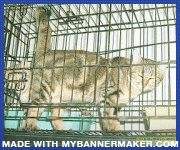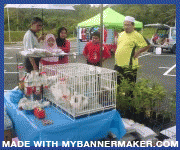Angora Grooming
Jan Rebmann
My first bunny, Angel, is an English Angora. I got her as a 10 week old baby and assumed that her fur would take care of itself somehow. It took a year and many big unmanageable mats to realize that the fur needed constant attention. She once had 8 inch long fur! I thought it was strange that she never really shed. All the new growth was getting tangled in the old coat and forming mats. I cut the fur short to even out the patches of mats I cut out and discovered that the coat was much more manageable while short. She is also more comfortable with short fur and there is less risk of her ingesting large amounts of long fur when she grooms. So, now I keep it short. I use a small grooming scissors with the ball tip. They are usually advertised as grooming shears for around the mouth, nose and ears of pets.

I pick up the fur some and put my thumb and forefinger between her skin and the scissors and cut away all over. It looks a little choppy at first, but after a few days the undercoat comes out and it evens out all around. I brush her everyday without fail to remove old fur so that it does not tangle up with the new.
I have found that using electric clippers is virtually useless as the blades clog constantly with the fine fur and it takes experience and expertise to use them correctly. There is also the risk of inadvertently gouging the skin with clippers.
So, here are some of the things I learned about angora fur management:
Since I have 3 angoras I have extensive experience with their grooming. My daughter, the vet tech, helps me clip them when they get matted. Even with all our experience and care, one of my bunnies got so stressed she stopped eating after being clipped and needed fluids and pain meds to get her through. Now we can only clip her for 10 minutes tops at any time. So you must constantly be aware of how the bunny is reacting.
Do not use a groomer. Your rabbit-savvy vet can do any shaving and clipping needed.















No comments:
Post a Comment